Effect of Hot Rolling on Microstructural Evolution and Wear Behaviors of G20CrNi2MoA Bearing Steel
Abstract
1. Introduction
2. Material and Experiments
3. Results and Discussion
3.1. Variation in Grain Size
3.2. Carbon Concentration Distribution Behavior
3.3. Evolution of Carbides
3.4. Mechanical Properties
3.4.1. Hardness Analysis
3.4.2. Wear Resistance Properties
4. Conclusions
- Hot rolling reduction can promote grain refinement. After 45% hot rolling reduction, the average grain size decreased by 20%, and the large-angle grain boundary increased from 45.67 to 51.73%. The grains obtained after CQT and RQT inherited this refinement, but the high austenitizing temperature during carburization weakened the refining effect.
- Hot rolling reduction can promote the diffusion of carbon atoms in the carburizing process. The surface carbon concentration increased from 0.84 to 0.92% with the increase in hot rolling reduction. The carbon concentration gradients in RQT specimens were not altered significantly by the low austenitizing temperature in the RQT stage.
- With the increase in hot rolling reduction, the average sizes of carbides decreased, and the area fraction increased. The increase in carbon content in the matrix after carburization due to the hot rolling reduction provided the composition conditions for the precipitation of carbides, and the increase in defect numbers inside the grains provided more nucleation sites for the carbides.
- With the increase in hot rolling reduction, the Vickers hardness increased, and the wear rate significantly decreased. The analysis of the friction performance indicated that that the wear resistance of the sample with large initial thermal deformation was superior due to the refined carbides and higher hardness.
- The results suggest that the wearability of carburized G20CrNi2MoA bearing steels can be further improved by optimizing the CQT and RQT processes after applying large hot deformation to the raw materials.
Author Contributions
Funding
Institutional Review Board Statement
Informed Consent Statement
Data Availability Statement
Acknowledgments
Conflicts of Interest
References
- Leboeuf, M. High-Speed Rail: Opportunities and Threats. Engineering 2016, 2, 402–408. [Google Scholar] [CrossRef]
- Zhang, Q.; Yang, H.J.; Wang, Q. Impact of high-speed rail on China’s big three airlines. Transp. Res. Part A Policy Pract. 2017, 98, 77–85. [Google Scholar] [CrossRef]
- Xu, Z.W.; Wu, S.C.; Wang, X.S. Fatigue evaluation for high-speed railway axles with surface scratch. Int. J. Fatigue 2019, 123, 79–86. [Google Scholar] [CrossRef]
- Sandor, L.T.; Politori, I.; Gonçalves, C.S.; Uehara, A.Y.; Leal, C.V.; Sato, M.; Ferreira, I. Fatigue crack propagation in nine steels, type SAE 43XX, from 0.20 to 1.00% C, for the simulation of the fatigue behavior in a carburized layer of the SAE 4320. Procedia Eng. 2010, 2, 735–742. [Google Scholar] [CrossRef]
- Wang, Y.H.; Yang, Z.N.; Zhang, F.C.; Qin, Y.M.; Wang, X.B.; Lv, B. Microstructures and properties of a novel carburizing nanobainitic bearing steel. Mater. Sci. Eng. A 2020, 777, 139086. [Google Scholar] [CrossRef]
- Long, S.L.; Liang, Y.L.; Jiang, Y.; Liang, Y.; Yang, M.; Yi, Y.L. Effect of quenching temperature on martensite multi-level microstructures and properties of strength and toughness in 20CrNi2Mo steel. Mater. Sci. Eng. A 2016, 676, 38–47. [Google Scholar] [CrossRef]
- Hua, L.; Deng, J.D.; Qian, D.S. Recent development of ring rolling theory and technique. Int. J. Mater. Prod. Technol. 2017, 54, 65–87. [Google Scholar] [CrossRef]
- Hua, L.; Deng, J.D.; Qian, D.S.; Lan, J.; Long, H. Modeling and application of ring stiffness condition for radial-axial ring rolling. Int. J. Mach. Tools Manuf. 2016, 110, 66–79. [Google Scholar] [CrossRef]
- Qian, D.S.; Hua, L. Blank design optimization for stepped-section profile ring rolling. Sci. China Technol. Sci. 2010, 53, 1612–1619. [Google Scholar] [CrossRef]
- Qian, D.S.; Pan, Y. 3D coupled macro-microscopic finite element modelling and simulation for combined blank-forging and rolling process of alloy steel large ring. Comput. Mater. Sci. 2013, 70, 24–36. [Google Scholar] [CrossRef]
- Qian, D.S.; Wang, K.W.; Liu, Q.L.; Hua, L. Effect of annealing parameters on microstructure and mechanical property of hot-rolled 100Cr6 bearing ring. Mater. Sci. Technol. 2016, 32, 1086–1093. [Google Scholar] [CrossRef]
- Zhou, G.H.; Wei, W.T.; Liu, Q.L. Influence of plastic deformation on microstructural evolution of 100Cr6 bearing ring in hot ring rolling. Materials 2020, 13, 4355. [Google Scholar] [CrossRef] [PubMed]
- Muszka, K.; Dziedzic, D.; Madej, L.; Majta, J.; Hodgson, P.D.; Palmiere, E.J. The development of ultrafine-grained hot rolling products using advanced thermomechanical processing. Mater. Sci. Eng. A 2014, 610, 290–296. [Google Scholar] [CrossRef]
- Chen, S.; Butler, J.; Melzer, S. Effect of asymmetric hot rolling on texture, microstructure and magnetic properties in a non-grain oriented electrical steel. J. Magn. Magn. Mater. 2014, 368, 342–352. [Google Scholar] [CrossRef]
- Gao, F.; Liu, Z.Y.; Liu, H.T.; Wang, G.D. Texture evolution and formability under different hot rolling conditions in ultra purified 17%Cr ferritic stainless steels. Mater. Charact. 2013, 75, 93–100. [Google Scholar] [CrossRef]
- Su, S.R.; Wang, L.; Song, R.B.; Wang, Y.J.; Li, J.K.; Chen, C. Gradient microstructure evolution and hardening mechanism of carburized steel under novel heat treatment. Mater. Lett. 2020, 280, 128486. [Google Scholar] [CrossRef]
- Sugianto, A.; Narazaki, M.; Kogawara, M.; Shirayori, A.; Kim, S.; Kubota, S. Numerical simulation and experimental verification of carburizing-quenching process of SCr420H steel helical gear. J. Mater. Process. Technol. 2009, 209, 3597–3609. [Google Scholar] [CrossRef]
- Roy, S.; Sundararajan, S. The effect of heat treatment routes on the retained austenite and Tribomechanical properties of carburized AISI 8620 steel. Surf. Coat. Technol. 2016, 308, 236–243. [Google Scholar] [CrossRef]
- Apple, C.A.; Krauss, G. Microcracking and Fatigue in a Carburized Steel. Metall. Trans. 1973, 4, 1195–1200. [Google Scholar] [CrossRef]
- Pacheco, J.; Krauss, G. Microstructure and high bending fatigue strength in carburized steel. J. Heat Treat. 1989, 7, 77–86. [Google Scholar] [CrossRef]
- Cao, Z.X.; Shi, Z.Y.; Yu, F.; Sugimoto, K.; Cao, W.Q.; Weng, Y.Q. Effects of double quenching on fatigue properties of high carbon bearing steel with extra-high purity. Int. J. Fatigue 2019, 128, 105176. [Google Scholar] [CrossRef]
- Li, Z.X.; Tong, B.Q.; Zhang, Q.L.; Yao, J.H.; Kovalenko, V. Microstructure refinement and properties of 1.0C-1.5Cr steel in a duplex treatment combining double quenching and laser surface quenching. Mater. Sci. Eng. A 2020, 776, 138994. [Google Scholar] [CrossRef]
- Lu, B.H.; Wei, W.T.; Mao, H.J.; Lu, X.H. Effect of cold ring rolling on the wear resistance of GCr15 bearing steel after quenching and tempering. Metals 2019, 9, 647. [Google Scholar] [CrossRef]
- Li, Z.X.; Li, C.S.; Ren, J.Y.; Li, B.Z.; Zhang, J.; Ma, Y.Q. Effect of cold deformation on the microstructure and impact toughness during the austenitizing process of 1.0C–1.5Cr bearing steel. Mater. Sci. Eng. A 2016, 674, 262–269. [Google Scholar] [CrossRef]
- Wang, F.; Qian, D.S.; Hua, L.; Lu, X.H. The effect of prior cold rolling on the carbide dissolution, precipitation and dry wear behaviors of M50 bearing steel. Tribol. Int. 2019, 132, 253–264. [Google Scholar] [CrossRef]
- Lu, B.H.; Hua, L.; Han, X.H.; Zhou, G.H. Microstructure evolution of GCr15 in cold ring rolling and following heat treatment. Mater. Sci. Technol. 2016, 32, 1702–1711. [Google Scholar] [CrossRef]
- Cao, Y.G.; Yin, C.H.; Liang, Y.L.; Tang, S.H. Lowering the coefficient of martensite steel by forming a self-lubricating layer in dry sliding wear. Mater. Res. Express 2019, 6, 55024. [Google Scholar] [CrossRef]
- Yin, C.H.; Liang, Y.L.; Liang, Y.; Li, W.; Yang, M. Formation of a self-lubricating layer by oxidation and solid-state amorphization of nano-lamellar microstructures during dry sliding wear tests. Acta Mater. 2019, 166, 208–220. [Google Scholar] [CrossRef]
- Li, B.Z.; Li, C.S.; Wang, Y.; Jin, X. Effect of Cryogenic Treatment on Microstructure and Wear Resistance of Carburized 20CrNi2MoV Steel. Metals 2018, 8, 808. [Google Scholar] [CrossRef]
- Zhang, S.W.; Yang, M.; Liang, Y.L.; Jiang, Y.; Long, S.L. Constitutive equations and dynamic recrystallization behaviors of 20CrNi2Mo steel at stage of high temperature deformation. Iron Steel 2017, 52, 97–106. [Google Scholar]
- Guo, J.; Qian, D.S.; Deng, J.D. Grain refinement limit during hot radial ring rolling of as-cast GCr15 steel. J. Mater. Process. Technol. 2016, 231, 151–161. [Google Scholar] [CrossRef]
- Zhao, Z.Y.; Guan, R.G.; Shen, Y.F.; Bai, P.K. Grain refinement mechanism of Mg-3Sn-1Mn-1La alloy during accumulative hot rolling. J. Mater. Sci. Technol. 2021, 91, 251–261. [Google Scholar] [CrossRef]
- Rao, K.P.; Oruganti, R.K. Study of hot deformation through energy storage concept. J. Mater. Process. Technol. 2003, 138, 97–101. [Google Scholar] [CrossRef]
- Khani Sanij, M.H.; Ghasemi Banadkouki, S.S.; Mashreghi, A.R.; Moshrefifar, M. The effect of single and double quenching and tempering heat treatments on the microstructure and mechanical properties of AISI 4140 steel. Mater. Des. 2012, 42, 339–346. [Google Scholar] [CrossRef]
- Liu, J.; Yu, H.; Zhou, T.; Song, C.H.; Zhang, K. Effect of double quenching and tempering heat treatment on the microstructure and mechanical properties of a novel 5Cr steel processed by electro-slag casting. Mater. Sci. Eng. A 2014, 619, 212–220. [Google Scholar] [CrossRef]
- Xie, R.W.; Lu, S.; Li, W.; Tian, Y.Z.; Vitos, L. Dissociated dislocation-mediated carbon transport and diffusion in austenitic iron. Acta Mater. 2020, 191, 43–50. [Google Scholar] [CrossRef]
- Lee, S.J.; Clarke, K.D. A Quantitative Investigation of Cementite Dissolution Kinetics for Continuous Heating of Hypereutectoid Steel. Metallurgical and materials transactions. Metall. Mater. Trans. A 2015, 46, 3917–3923. [Google Scholar] [CrossRef]
- Preciado, M.; Pellizzari, M. Influence of deep cryogenic treatment on the thermal decomposition of Fe-C martensite. J. Mater. Sci. 2014, 49, 8183–8191. [Google Scholar] [CrossRef]
- Barrow, A.T.W.; Kang, J.H.; Rivera-Díaz-Del-Castillo, P.E.J. The ϵ→η→θ transition in 100Cr6 and its effect on mechanical properties. Acta Mater. 2012, 60, 2805–2815. [Google Scholar] [CrossRef]
- Grange, R.A.; Hribal, C.R.; Porter, L.F. Hardness of tempered martensite in carbon and low-alloy steels. Metall. Trans. A 1977, 8, 1775–1785. [Google Scholar] [CrossRef]
- Klecka, M.A.; Subhash, G.; Arakere, N.K. Microstructure-property relationships in M50NiL and P675 case hardened bearing steels. Tribol. Trans. 2013, 56, 1046–1059. [Google Scholar] [CrossRef]
- Lian, J.L.; Zheng, L.J.; Wang, F.; Zhang, H. Evolution of carbides on surface of carburized M50NiL bearing steel. J. Iron Steel Res. Int. 2018, 25, 1198–1211. [Google Scholar] [CrossRef]
- Michaud, P.; Delagnes, D.; Lamesle, P.; Mathon, M.H.; Levaillant, C. The effect of the addition of alloying elements on carbide precipitation and mechanical properties in 5% chromium martensitic steels. Acta Mater. 2007, 55, 4877–4889. [Google Scholar] [CrossRef]
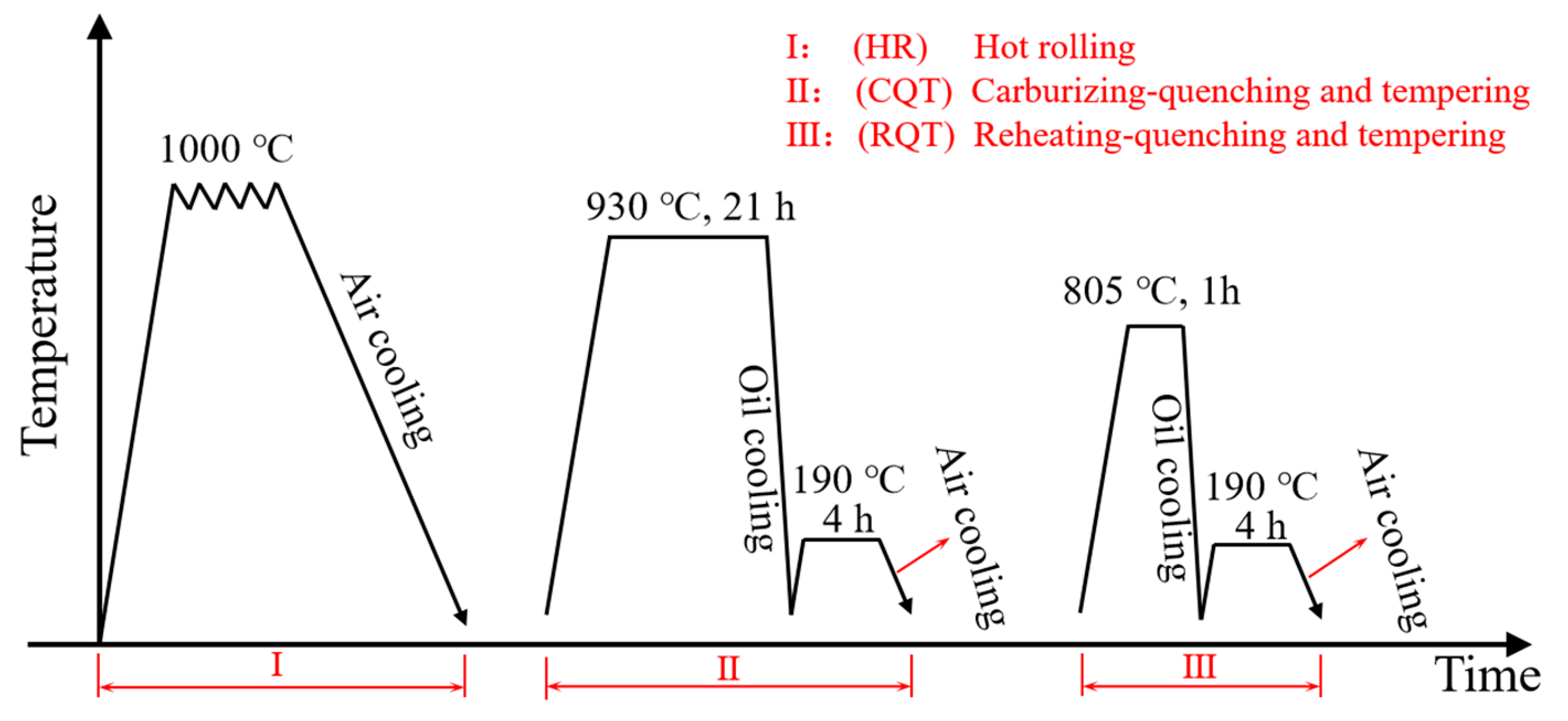
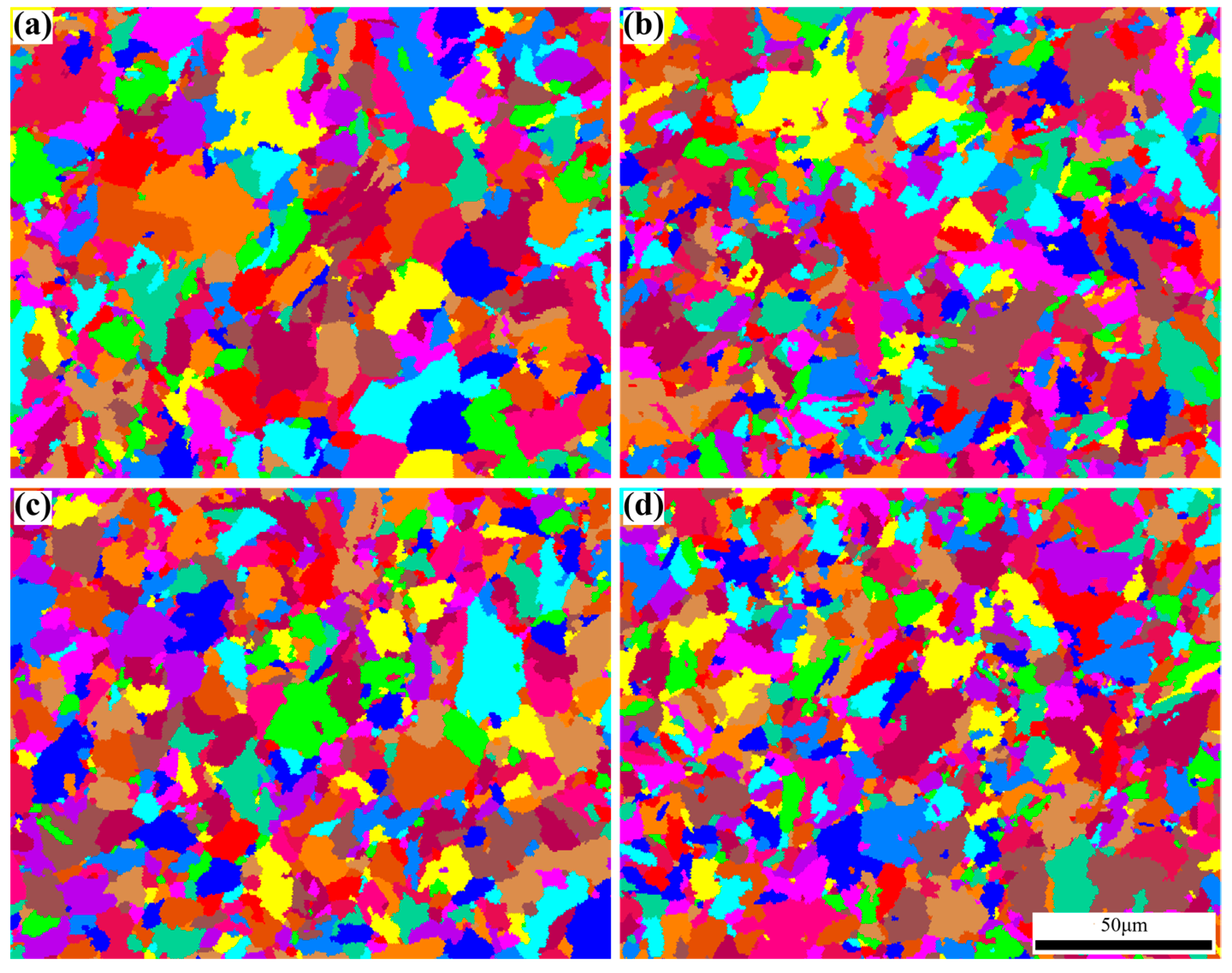
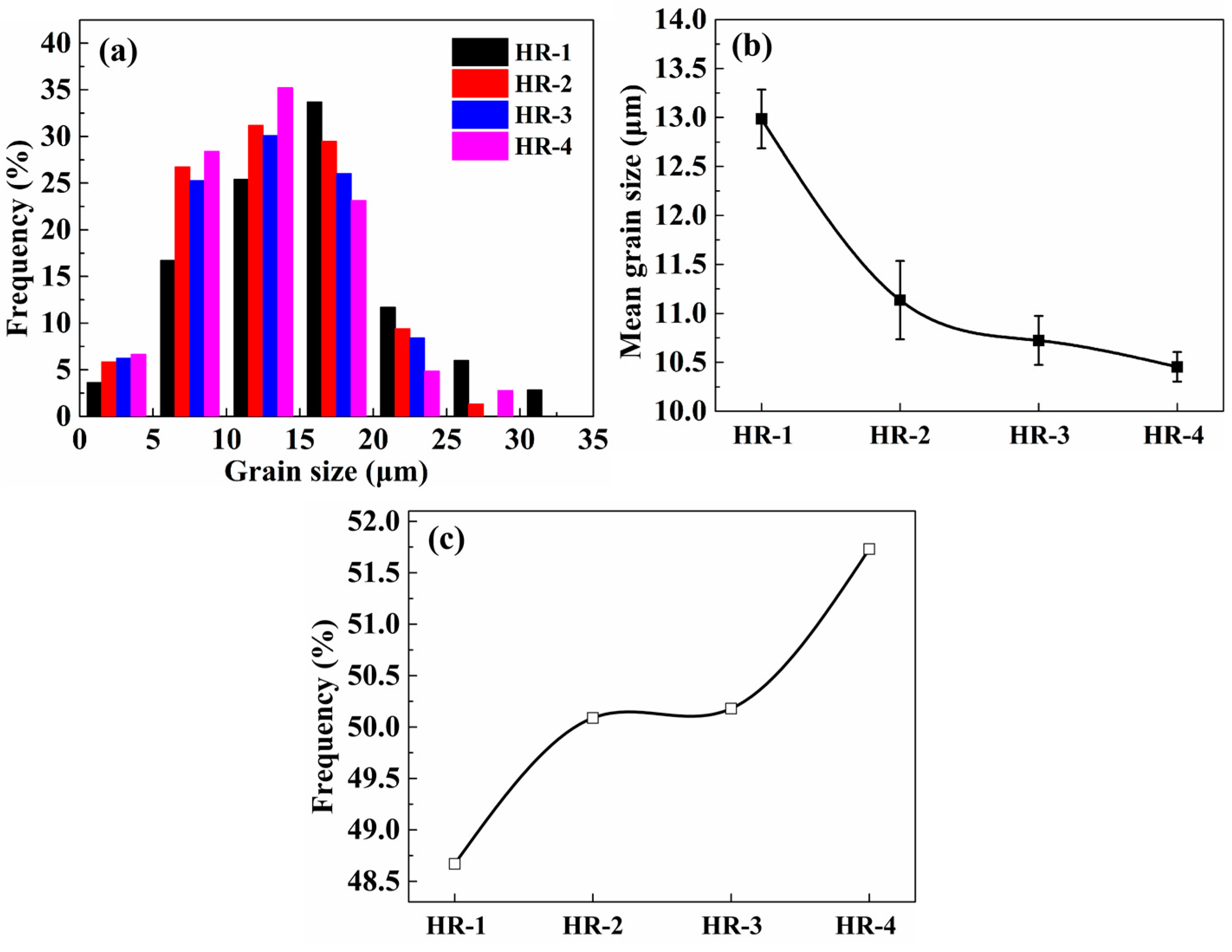
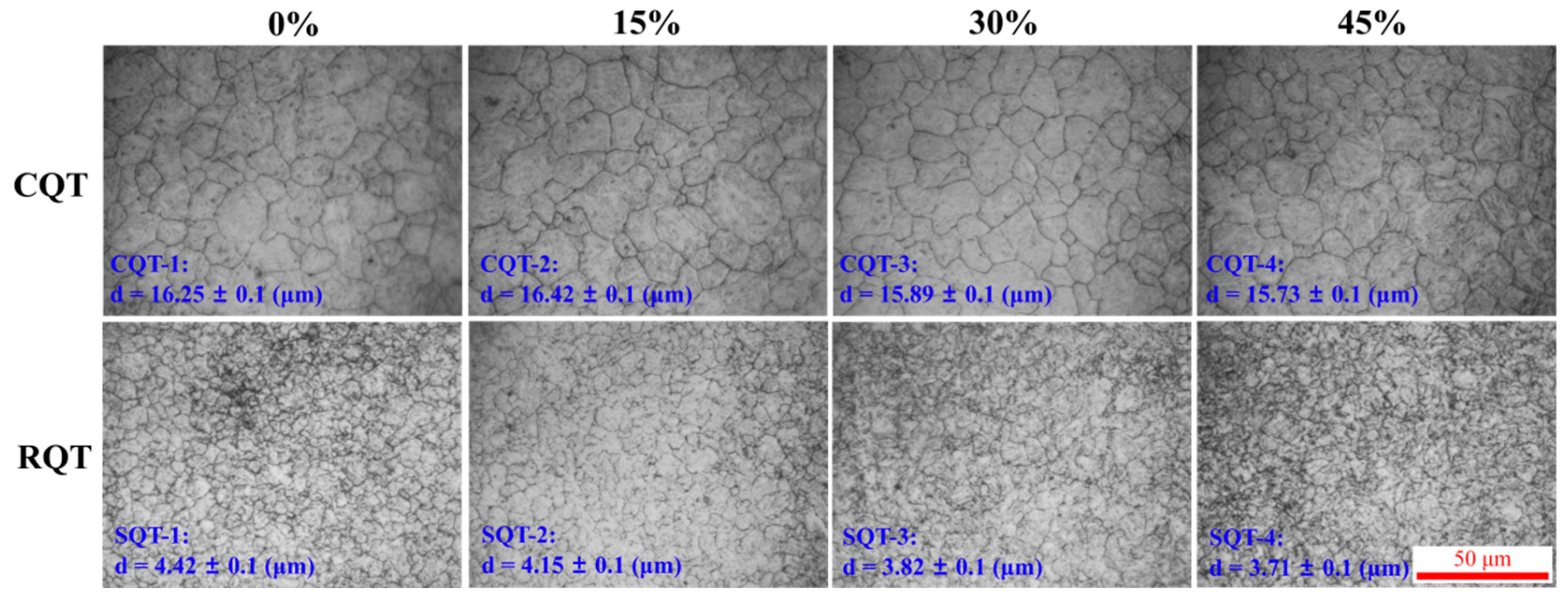
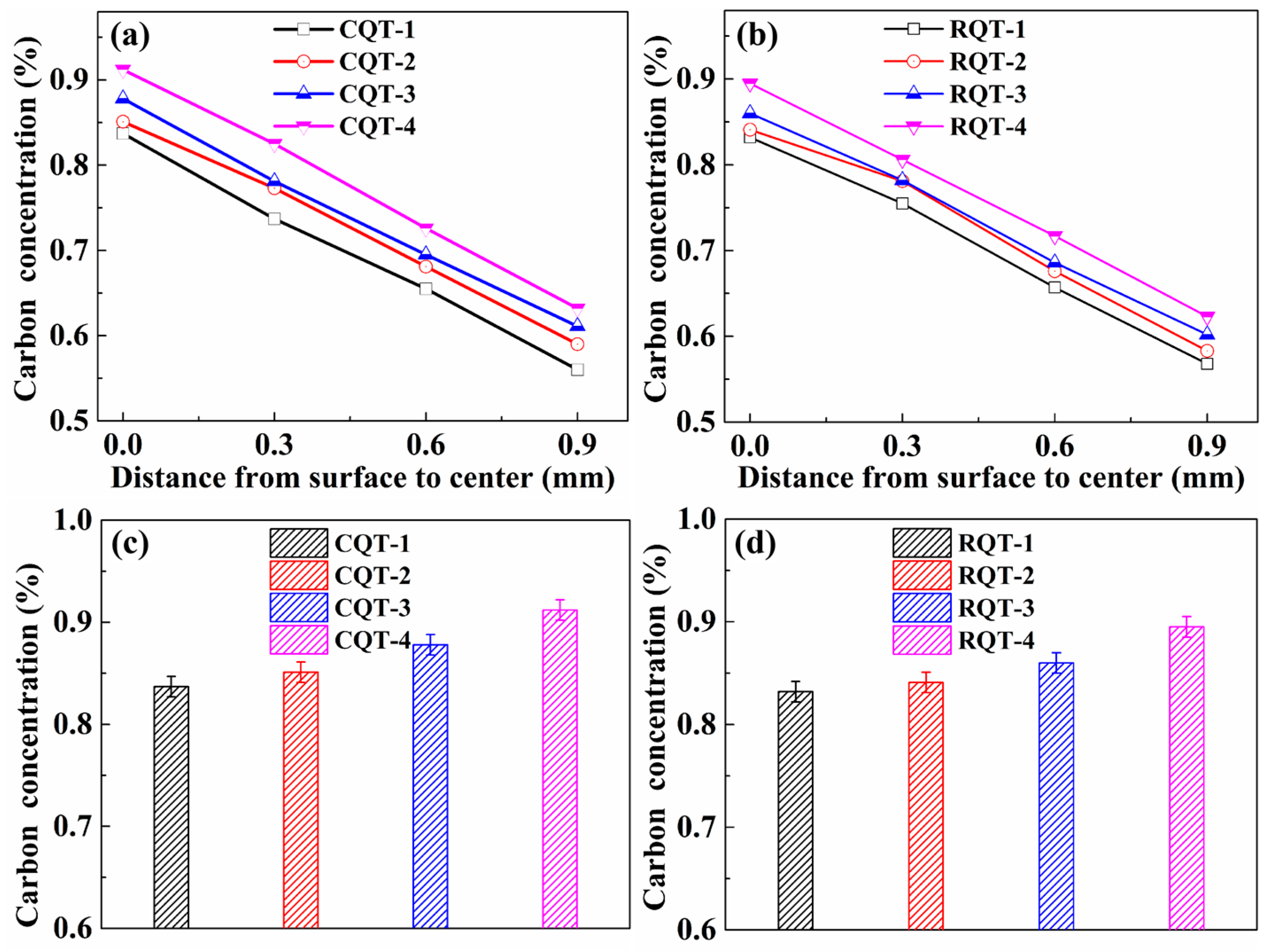
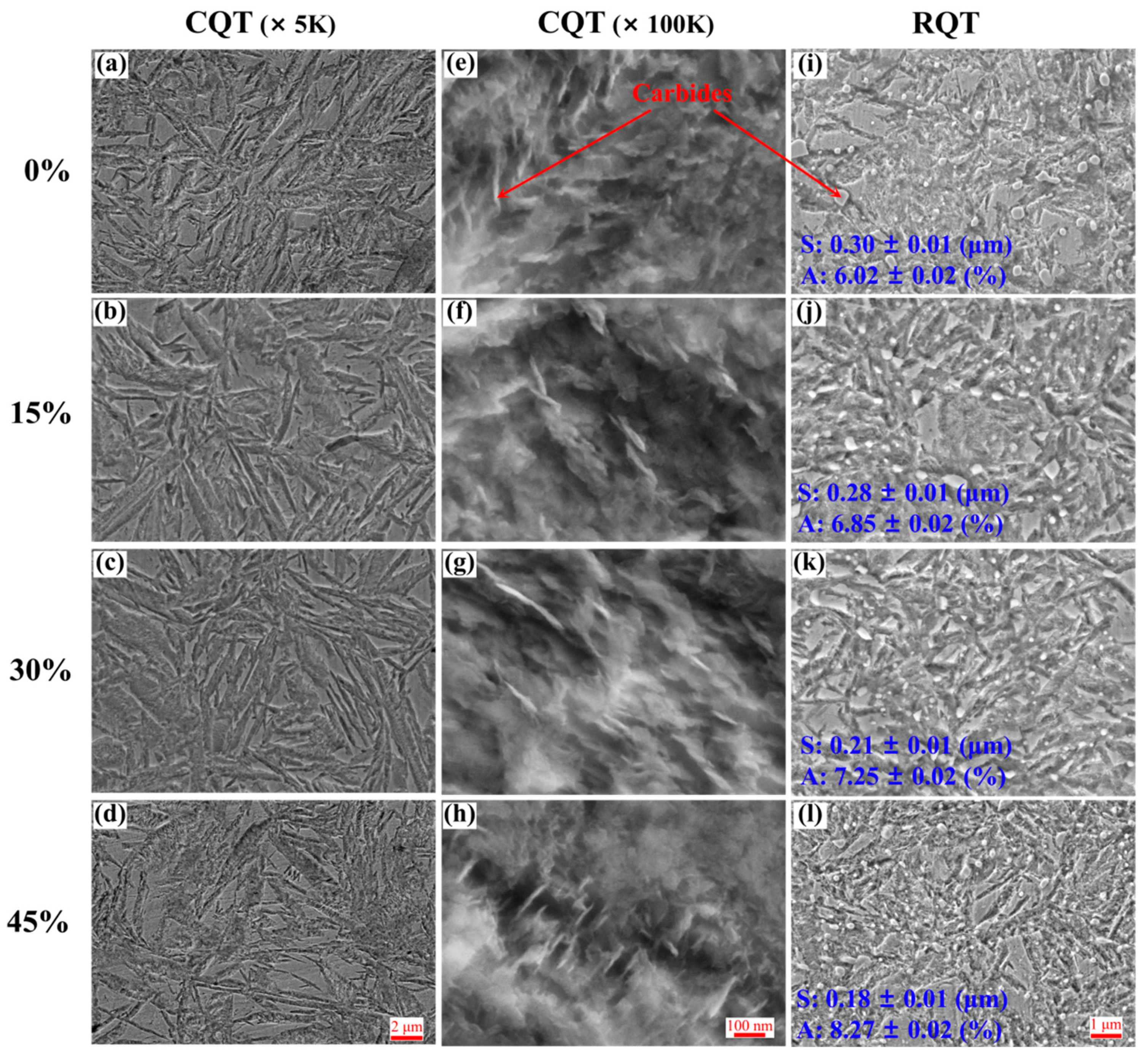

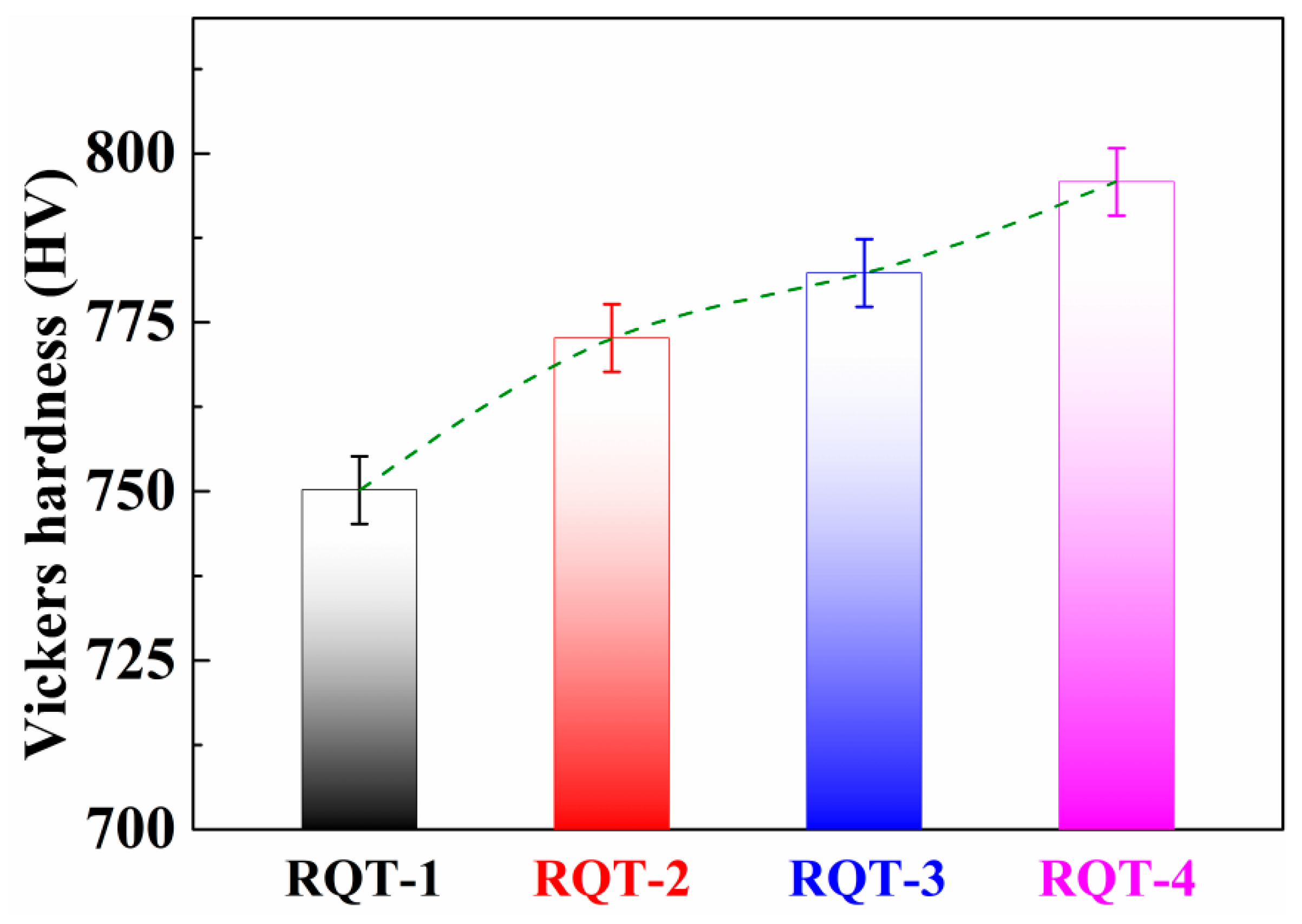
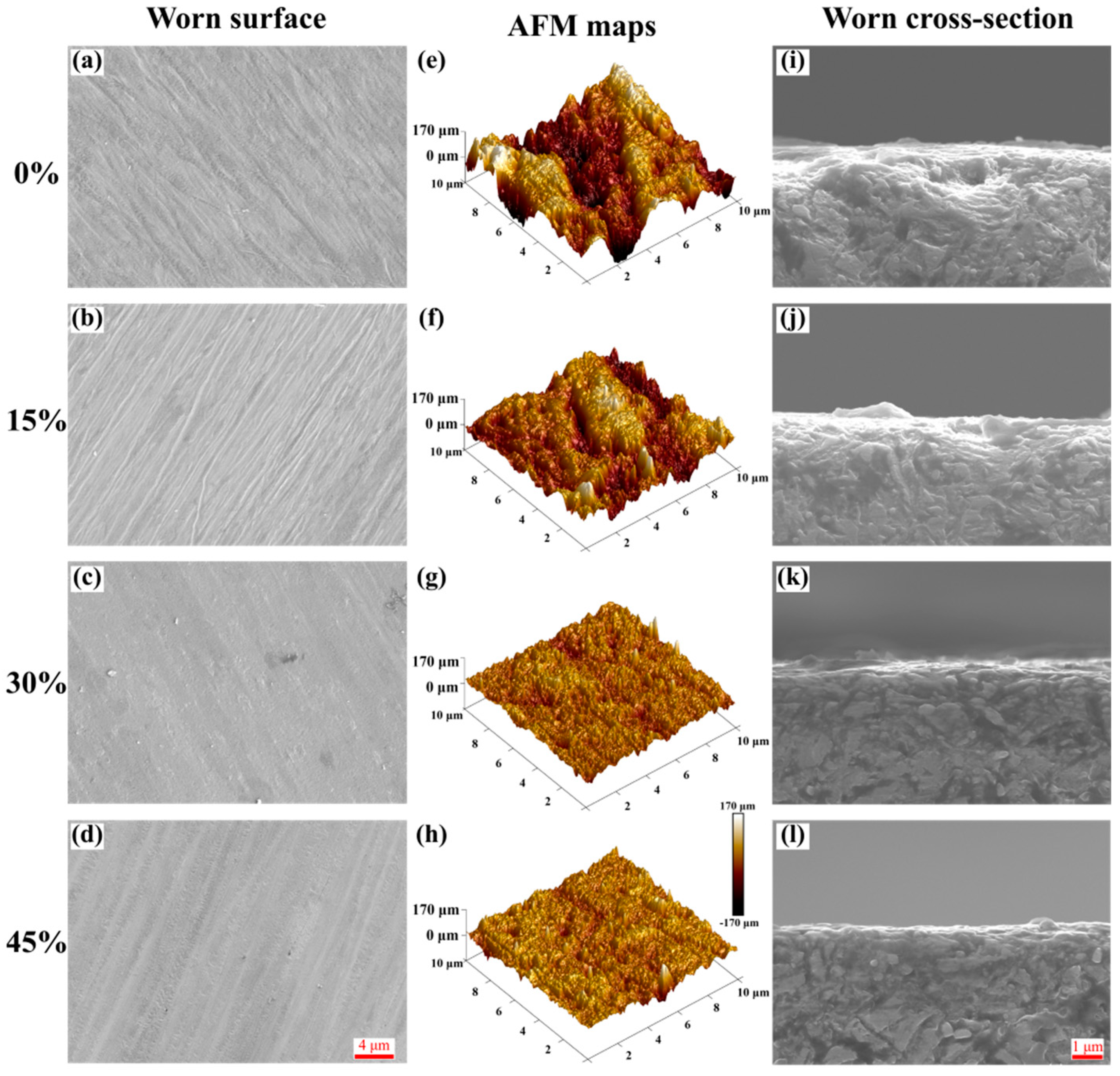
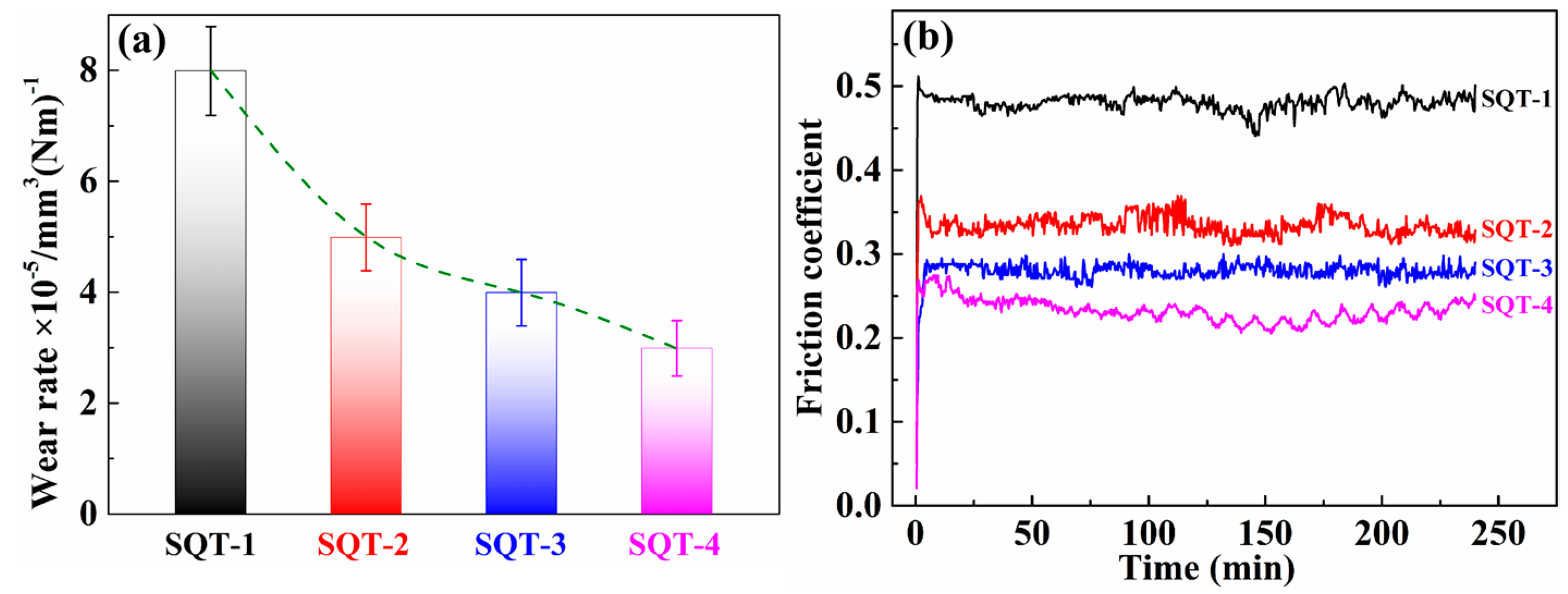
| Steel | C | Cr | Ni | Mo | Si | Mn | P | S | Fe |
|---|---|---|---|---|---|---|---|---|---|
| G20CrNi2MoA | 0.22 | 0.54 | 1.77 | 0.25 | 0.35 | 0.64 | ≤0.02 | ≤0.01 | bal |
| Process | Thickness Reduction Rates | |||
|---|---|---|---|---|
| 0% | 15% | 30% | 45% | |
| HR | HR-1 | HR-2 | HR-3 | HR-4 |
| CQT | CQT-1 | CQT-2 | CQT-3 | CQT-4 |
| RQT | RQT-1 | RQT-2 | RQT-3 | RQT-4 |
Publisher’s Note: MDPI stays neutral with regard to jurisdictional claims in published maps and institutional affiliations. |
© 2021 by the authors. Licensee MDPI, Basel, Switzerland. This article is an open access article distributed under the terms and conditions of the Creative Commons Attribution (CC BY) license (https://creativecommons.org/licenses/by/4.0/).
Share and Cite
Zhou, G.; Wei, W.; Liu, Q. Effect of Hot Rolling on Microstructural Evolution and Wear Behaviors of G20CrNi2MoA Bearing Steel. Metals 2021, 11, 957. https://doi.org/10.3390/met11060957
Zhou G, Wei W, Liu Q. Effect of Hot Rolling on Microstructural Evolution and Wear Behaviors of G20CrNi2MoA Bearing Steel. Metals. 2021; 11(6):957. https://doi.org/10.3390/met11060957
Chicago/Turabian StyleZhou, Guanghua, Wenting Wei, and Qinglong Liu. 2021. "Effect of Hot Rolling on Microstructural Evolution and Wear Behaviors of G20CrNi2MoA Bearing Steel" Metals 11, no. 6: 957. https://doi.org/10.3390/met11060957
APA StyleZhou, G., Wei, W., & Liu, Q. (2021). Effect of Hot Rolling on Microstructural Evolution and Wear Behaviors of G20CrNi2MoA Bearing Steel. Metals, 11(6), 957. https://doi.org/10.3390/met11060957





